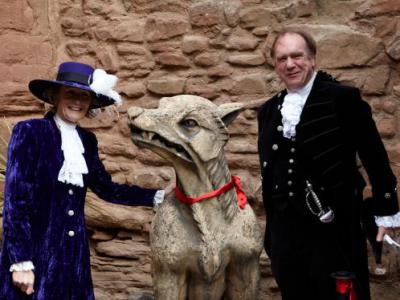Official unveiling of the castle beast!

Tamworth Castle has officially unveiled their mythical beast sculpture made by Tamworth company Gibbs and Canning Limited back in the 1880s, last week on February 12.
The event took place in the castle courtyard with special VIP guests - the Staffordshire High Sheriff James Friend, accompanied by his wife Mrs Sanda Friend; the Warwickshire High Sheriff Lady Willoughby de Broke and Councillor Robert Pritchard.
Guests, including representatives of the Friends of Tamworth Castle and local history groups, were invited to the grand reveal with a short presentation and ribbon cutting by both High Sheriffs, followed by refreshments in the castle Townshend room. This is the first of many planned events to highlight the collection pieces of Gibbs and Canning held by Tamworth Castle and our Tamworth Heritage Trail.
The installation of the terracotta piece took place at the castle in December 2021, with Richard Rogers, the director of the conservation company, on site working with K Pak Ltd, Fine Art Services who transported and lifted the Griffin into position, a challenging undertaking considering the access to the castle. The beast now has two additional smaller terracotta pieces from the castle collections to complete a small display in the courtyard with interpretation.
The impressive beast statue of a Griffin or Gryphon, is one of a number that were created to decorate the external walls of the Natural History Museum in London, designed by the architect Sir Alfred Waterhouse.
This Griffin never made it onto the building itself due to the process of firing terracotta, extras were made to allow for any loss or damage in production, transport, or installation.
The statue is made of terracotta from local clay, a by-product of the coal extracted in the Glascote area of Tamworth. It is mostly hollow inside but still weighs a substantial amount even without the base plinth.
The beast was originally moulded and fired in two halves and stored in two separate pieces. Thanks to the government Cultural Recovery Fund, along with a contribution from the Friends of Tamworth Castle, specialist restoration was able to take place to ensure it can be displayed in the castle courtyard.
Following the closure of Gibbs and Canning in the 1970s, the Griffin has been housed in Tamworth Castle’s off-site museum store, along with a number of the other terracotta samples, some of which can now be seen on the new castle collections digital website.
Tamworth Castle was able to preserve samples of the terracotta, as well as the business records of Gibbs and Canning when the company closed in the 1970s. These records are held in the castle collection archives.
Gibbs and Canning were successful terracotta manufacturers established in February 1846. They became famous nationally and internationally for their production of fine architectural terracotta pieces and glazed tiles commissioned for buildings in London and the Midlands, Hong Kong, USA and Canada.
At the end of the 19th century almost 300 local Tamworth people were employed by the manufacturers. The homes of directors and workers alike can be found on the Glascote Road, with many frontages still having the terracotta brickwork around the front doors and windows, and glazed tiles in the entrance porches.
You can find out more about Gibbs and Canning, their products and the buildings they were involved with across the world by going online, or by visiting Tamworth Castle’s digital collections website, where you can see more amazing samples of Gibbs and Canning terracotta: https://collection.tamworthcastle.co.uk .
Andrew Barratt, Chief Executive at Tamworth Borough Council, said: “During the past year we have seen many of the council’s exciting plans for Tamworth Castle taking shape as we work on developing it even further as a major tourist attraction for the town and celebrate our rich heritage.
“We are delighted to officially launch the arrival of this statue in the castle courtyard for visitors to see when they arrive to tour our ancient monument.
“The Griffin may look familiar to some if you are a fan of the film ‘Paddington 2’. A similar beast is seen during the scene where Mr Brown, played by actor Hugh Bonneville, appears to make his way across the outside of the Natural History Museum building to rescue Paddington from the taxidermist.
“The castle team have worked hard to ensure that the castle experience meets the expectations of modern audiences and having the Griffin on display is truly the icing on the cake to showcase the incredible work of such a successful international and locally based manufacturer such as Gibbs and Canning.”





